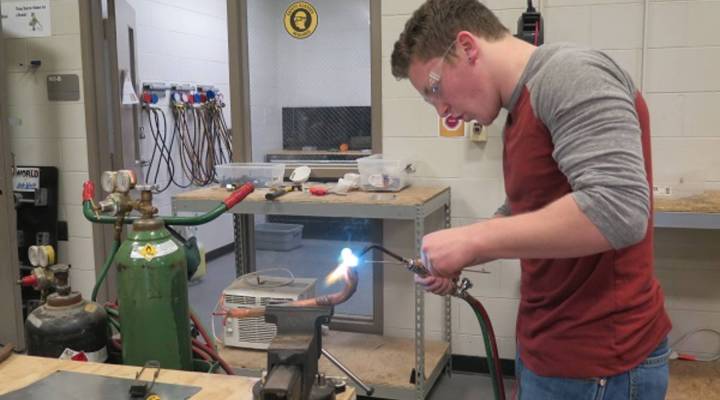
A program that mixes academics with vocational training

More than 1,200 students come to the Carroll County College and Career Academy on any given day to take career classes. The school is west of Atlanta, near the Alabama border. Students here learn fields as varied as culinary arts, welding and auto mechanics. They all go to one of the five regular high schools in the district for their other classes, like math and history, then come here for job skills.
“This is sort of a tree,” said 11th grader Jordan Decker, who was using a torch to melt pieces of metal together, making a little shape, to practice his brazing skills. The 17-year-old 11th grader is studying heating ventilation and air condition maintenance and repair, or HVAC.
“Without this program, I’d still be trying to find what I wanted to do with my life,” said Decker. “This is what I want to do.”
The proportion of high school students who take classes in, say, construction, has gone down over the past couple decades. Meanwhile, employers in construction and other industries say they can’t find enough skilled workers. But vocational training hasn’t gone away completely. Some school districts are really emphasizing it. And it no longer comes with the old stereotype — that it’s for students who aren’t college material.
Most high schools offer some kind of career training, but a lot of that is focused on things like health care, or communications. Decker’s HVAC teacher, Steve McCray, said vocational training has changed.
“It used to be kind of a, I guess a dumping ground for troubled kids,” he said. “Now it’s for kids who want to go out there and want to get a job.”
And the school encourages the students here to continue with their educations after high school, too.
“You know, in the old days, it was some kids are going to college, and some kids are going to work, and you need to treat them differently,” said Bob Schwartz of the Harvard Graduate School of Education. “I think we now are beginning to understand, everybody needs something beyond a high school education, and everybody needs to be thinking from pretty early on, about a career.”
Several years ago, Schwartz and a couple of colleagues did a study on how prepared young people in America were to join the workforce. They found on the one hand, even though high schools have encouraged students to pursue college degrees, plenty of students never get that far. They end up without degrees or much career direction. “From the employer perspective,” said Schwartz, “they’re saying, ‘The skills gap is real. We simply can’t find people with the skills we need to be able to grow our businesses.’”
Schwartz said many high school dropouts later say one reason they didn’t stick with it, was they didn’t see how what they were learning applied to the real world.
In the last couple decades, the percentage of students taking classes in construction, manufacturing, and other trades has gone down, according to the National Center for Education Statistics. Meanwhile job prospects for people who do have those skills are good.
Take HVAC installation and repair, what student Jordan Decker is studying. According to the U.S. Bureau of Labor Statistics, that field will grow 14 percent by 2024, adding nearly 40,000 jobs. In Georgia, according to the state Department of Economic Development, there are more than 300 openings every year, both new jobs, and unfilled positions.
Carroll County revamped its technical education program in 2005. Since then, the school has doubled its enrollment, and the principal says a lot of that increase has been from the more academically-accomplished students deciding to come here. In 2015, more than 90 percent of the seniors who took classes here, graduated from high school. The school system’s average that year was 76 percent.
“I plan on getting a job doing this out of high school,” said Decker. “And then eventually going to college and working for either a big company or making it bigger myself.”
Teacher Steve McCray said he enjoys hearing from his former students. “It’s nice when they stop back by and they tell you, ‘Mr. McCray, look at my new truck, I’m buying my house,’” he said.
There’s a lot happening in the world. Through it all, Marketplace is here for you.
You rely on Marketplace to break down the world’s events and tell you how it affects you in a fact-based, approachable way. We rely on your financial support to keep making that possible.
Your donation today powers the independent journalism that you rely on. For just $5/month, you can help sustain Marketplace so we can keep reporting on the things that matter to you.












